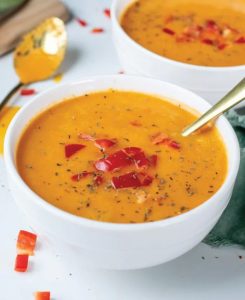Vegetable purees are a delightful and versatile addition to any meal plan. They are a fantastic way to incorporate more vegetables into your diet, especially for those who might find them unappetizing in their whole form. Purees can be enjoyed on their own, used as dips or sauces, or incorporated into other dishes for a boost of flavor and nutrients.
This comprehensive guide dives into the world of pureed vegetables, exploring everything from selecting the perfect ingredients to mastering different preparation techniques.
Selecting the Right Vegetables
The key to a delicious puree lies in choosing the right vegetables.
-
Sweet Vegetables: Sweet vegetables like carrots, sweet potatoes, butternut squash, and beets lend themselves well to purees as their natural sweetness enhances the final dish.
-
Starchy Vegetables: Starchy vegetables like potatoes, parsnips, and turnips add a creamy texture and body to purees.
-
Green Vegetables: Broccoli, peas, spinach, and kale can be incorporated into purees for a touch of bitterness that is balanced by other flavors.
-
Cruciferous Vegetables: Cauliflower and cauliflower offer a slightly nutty flavor and a mild texture, making them perfect for purees.
Pro Tip: Don’t be afraid to experiment with different vegetable combinations to create unique flavor profiles.
Essential Pureeing Techniques
There are several methods for achieving a smooth and silky vegetable puree.
Boiling:
This is a simple and effective method. Simply place chopped vegetables in a pot of boiling water and cook until tender. Drain the water and puree the vegetables using an immersion blender or a food processor.
Steaming:
Steaming vegetables helps preserve their nutrients and vibrant colors. Steam chopped vegetables until tender and then puree them as described above.
Roasting:
Roasting vegetables intensifies their flavor and adds a touch of smokiness. Roast vegetables until tender and caramelized, then puree them.
No matter which method you choose, ensure the vegetables are cooked until very soft for the smoothest puree.

Flavor Boosters for your Puree
Several ingredients can elevate your vegetable puree from ordinary to extraordinary.
-
Herbs and Spices: Fresh herbs like parsley, basil, and cilantro, or spices like cumin, curry powder, or smoked paprika, add depth of flavor to purees.
-
Cheese: Nutty cheeses like parmesan or ricotta add a creamy richness to purees.
-
Cream or Milk: A splash of cream or milk can add richness and a velvety texture, but be mindful of adding too much if you are watching your fat intake.
-
Acidity: A squeeze of lemon juice or a splash of vinegar brightens the flavor of purees and helps to cut through richness.
Remember to add these ingredients sparingly to avoid overpowering the natural flavor of the vegetables.
Culinary Creations with Purees
Pureed vegetables are incredibly versatile and can be enjoyed in many ways. Here are some ideas to get you started:
Soups and Bisques:
Purees are the base for many creamy and flavorful soups and bisques. Simply thin your puree with broth or stock and add your favorite seasonings.
Sauces and Dips:
Purees can be used to create delicious sauces for pasta, vegetables, or protein. They can also be thinned with yogurt or tahini for a delightful dip.
Baby Food:
Pureed vegetables are a healthy and nutritious way to introduce solids to babies.
Baked Goods:
You can add pureed vegetables c to breads, muffins, and quick breads for added moisture, flavor, and nutrients.
Mashed Potato Alternatives:
Cauliflower puree or butternut squash puree can be a delicious alternative to mashed potatoes.
With a little creativity and these helpful tips, you can create restaurant-quality vegetable purees at home. So, don’t be afraid to experiment with different vegetables, flavors, and techniques to discover your own puree perfection!
Puree Perfection in the Kitchen: Tips and Tricks
Now that you’ve got the basics of selecting vegetables and creating smooth purees down, here are some additional tips and tricks to elevate your creations:
- Thickeners: If your puree seems too thin, you can add thickeners like mashed potatoes, cornstarch mixed with water, or arrowroot powder.
- Strain for Extra Smoothness: For an especially silky puree, pass it through a fine-mesh sieve after processing.
- Garnishes: Elevate the look and taste of your puree with simple garnishes like chopped fresh herbs, a drizzle of olive oil, or a sprinkle of toasted nuts or seeds.
- Storage: Leftover purees can be stored in airtight containers in the refrigerator for up to 3 days or frozen for longer storage. Reheat gently on the stovetop or in the microwave.
Beyond the Basics: Creative Puree Inspiration
- Swirls and Dollops: Use contrasting colored purees to create swirls or dollops for a visually stunning presentation.
- Rainbow Veggie Puree Platter: Prepare a variety of colorful purees and serve them with toasted pita bread or crackers for a fun and healthy appetizer.
- Hidden Veggie Power in Kid-Friendly Dishes: Sneak pureed vegetables into dishes like mac and cheese, or pasta sauce for a sneaky way to boost veggie intake.
With these tips and a little creativity, pureed vegetables can become a staple in your kitchen, adding flavor, variety, and essential nutrients to your meals.

Puree Perfection Around the World
Pureed vegetables are a delicious and nutritious element in cuisines around the world. Here’s a glimpse into some interesting international uses of vegetable purees:
-
Dal in India: This comforting lentil stew often incorporates pureed vegetables like lentils, tomatoes, and spices for a thick and flavorful base.
-
French Vichyssoise: This chilled potato and leek soup is a classic example of a silky smooth vegetable puree.
-
Japanese Pumpkin Croquettes: Mashed pumpkin is a common ingredient in these savory fritters, offering sweetness and moisture.
-
Italian Cavtat Pasta Sauce: This creamy sauce uses pureed cauliflower to create a lighter and healthier alternative to traditional Alfredo sauce.
-
Mexican Guacamole: This vibrant dip features mashed avocado as its main ingredient, along with lime juice, cilantro, and spices.
Exploring these international examples can inspire you to create your own unique and flavorful vegetable puree dishes.
Puree Perfection and Your Health
Vegetable purees offer a multitude of benefits beyond their delightful taste and versatility. Here’s how incorporating purees into your diet can support your well-being:
Increased Vegetable Intake:
Purees can make it easier to consume a wider variety of vegetables, which are essential for a balanced diet.
Enhanced Nutrient Absorption:
Cooking vegetables can break down some cell walls, making certain nutrients more bioavailable for your body to absorb.
Improved Digestion:
The smooth texture of purees makes them easier to digest, especially for people with digestive issues.
Hydration Booster:
Many vegetables have high water content, and purees can contribute to your daily fluid intake.
Weight Management:
Vegetable purees are generally low in calories and fat, making them a great choice for weight management or healthy eating plans.
By incorporating purees into your meals, you can experience these positive health effects and enjoy the delicious world of puréed vegetables!
